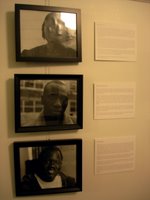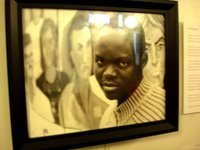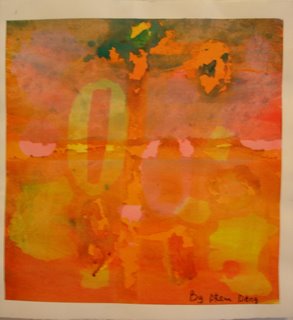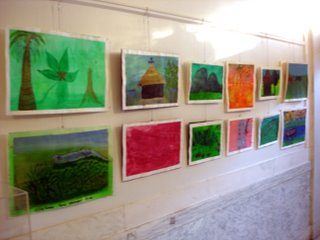
Visual art is the tool by which we are able to communicate ideas to a greater public. In an age of mass production and mass communications, the ability to send these images to all crevises and communities in the world (well as long as you have access to a computer, that is) is our modern way of participating in a time-old tradition: telling stories. Sharing stories that shed light on issues we may not have learned of otherwise and expose us to worlds very different from our. Every now and again they can open our minds to an experience outside of ours, motivate us to get involved, challenge us to make a change, however small. That is the motivation behind the exhibit at the Metropolitan Gallery, "Painting Faces on War: Brave Hearts of the Lost Boys and Girls of Sudan," an exhibit comprised of artwork and ethnographic materials.
 As Sarah Kariko said in an interview with the Seven Days: "It's a call to look. These paintings give a visual voice to those who have no other representations of their families and villages." Because there is so little photographic documentation of where they came from -- a part of Africa that's routinely ignored by the Western media -- "there's a whole generation of kids in the refugee camps who have not even an indirect experience of traditional life," Kariko notes.
As Sarah Kariko said in an interview with the Seven Days: "It's a call to look. These paintings give a visual voice to those who have no other representations of their families and villages." Because there is so little photographic documentation of where they came from -- a part of Africa that's routinely ignored by the Western media -- "there's a whole generation of kids in the refugee camps who have not even an indirect experience of traditional life," Kariko notes. 

Kariko, a sculptor, worked with artist and Sudanese refugee Atem Thuc Aleu on putting the show together. Aleu started his artistic studies in 1994 at the age of 14 under the tutelage and encouragement of UN aid workers. He soon became the art instructor for nearly 75 rufugees, using art as a tool of therapy and communication. "The year I started painting in Kakuma, I was having dreams of Sudan and of my people every night. Every morning I tried to draw my dream. I would often see people running and being shot."(Seven Days)
In 2001 he was one of the fortunate few to resettle in the United States, in his case, in Utah, where he is currently a student at Brigham Young University. Kariko and Aleu came together when she became involved in the activities of the Sudanese community here in Vermont and Aleu came to teach a course in art to that community. The show was born out their friendship and the art of the refugees.

Of particular poignancy in this exhibit are the ethnographic elements. Next to each photo of a refugee is a placard containing a short biography: where the refugee is from, when they came to the US, what they are doing now, and what they hope to do in the future. Some hint at the violence the individual encountered; others are more graphic, such as that of a young woman who was beaten with the butts of guns. Some talk of small achievements such as garnering a driver's license; others discuss achievements as students at UVM. All of the bios end with each person's desire to return home to find lost family members. The spectator leaves with a note of sadness: how difficult it must be to reconcile oneself with the fortune of resettling in a stable environment while family is still aboard in a hellish environment.

This show may be called "A Call to Look" but it's subtext is a call to engagement, to engage in a crisis and rectify it, to engage in the lives of others who simply want a stable existence for their family and friends. The show runs through August 7.






No comments:
Post a Comment